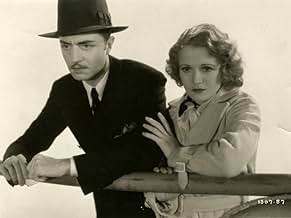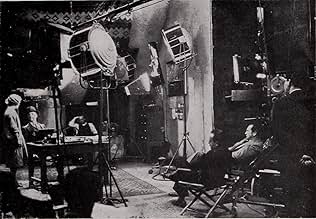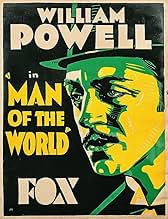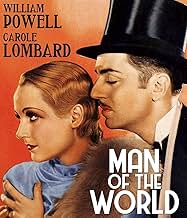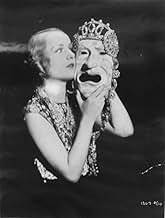Une jeune Américaine se rend à Paris avec son fiancé et son oncle millionnaire. Elle y rencontre un romancier mondain dont elle tombe amoureuse.Une jeune Américaine se rend à Paris avec son fiancé et son oncle millionnaire. Elle y rencontre un romancier mondain dont elle tombe amoureuse.Une jeune Américaine se rend à Paris avec son fiancé et son oncle millionnaire. Elle y rencontre un romancier mondain dont elle tombe amoureuse.
- Réalisation
- Scénario
- Casting principal
- Récompenses
- 1 victoire au total
- Undetermined Secondary Role
- (non crédité)
- Louis - Headwaiter
- (non crédité)
- Joe - American Tourist
- (non crédité)
- Spade Henderson
- (non crédité)
- Mr. Bradkin
- (non crédité)
- Hotel Desk Clerk
- (non crédité)
- Mrs. Jowitt
- (non crédité)
Avis à la une
This picture is very much the creaking early talkie. You know it is from the moment you start the DVD by the 1.20:1 screen aspect ratio. The sound strip on the edge of the film cut the 35 mm film frame's original 1.33:1 (same as an old standard TV screen) down to a claustrophobic, square-looking screen. By 1933 all the studios would adopt the "Accademy Standard" 1.37:1 screen by the simple expedient of a camera aperture mask. Early street scenes in Man Of The World are obviously stock footage from silent movies. But there was little other stock footage available then! When the movies started talking, there were three kinds of actors available -- those who had acted only in silents, stage actors, and actors who had experience in both media. But they and their directors soon learned that the talking picture was a whole new game. The melodramatic gestures needed to convey emotion in silent movies looked ridiculous with actual spoken dialog. Yet the stage style of acting would seem wooden in talking pictures. With microphones actors did not need to shout to be heard, and the motion picture camera could record subtle facial expressions and body movements which would have been lost on the third row of a live theater audience.
Both Powell and Lombard had stage as well as silent movie experience, though much more of the latter in her case. Powell, who would eventually develop a talking picture style of top caliber, was still working on it in Man Of The World. He seems a little stiff at times, and so does Wynne Gibson, but both are nevertheless very effective. Contrary to what some other reviewers have felt, I found Gibson's performance and asset, even though there were times when she was projecting to the back row seats. Carole Lombard's sound acting style with her sexy voice and fluid movement seems more natural, but then her part in the picture is not a particularly demanding one. Guy Kibbee, surprisingly, is the player who had the most secure handle on the new sound movie style. Perhaps it was his early experience as an entertainer in the intimate confines of a Mississippi riverboat.
The oft-used plot has slick con man Powell trying to work a blackmail scheme on naive American lass Lombard and her rich but dimwitted uncle Kibbee. With jealous ex-moll and confederate Gibson egging on the reluctant Powell. Predictably Powell falls in love with the sweet and beautiful Carole. However, all is very well done, things do not necessarily go according to formula, and the ending is something of a surprise.
Though I was about to give up on the Carole Lombard movies after watching two from the set, The Princess Comes Through, and We're Not Dressing (see my review), I was pleasantly surprised by Man Of The World. But then it was really a William Powell movie. Carole didn't have to do much except look good, and she did that very well indeed.
Man Of The World is rough around the edges but rewarding if you stick with it. At an hour and fourteen minutes, a good filler movie.
--------- Post Script (Jan 2014): Since writing this creaky old review, viewings of several other Carol Lombard Lombard pictures, including Love Before Breakfast (1936) (see my review) and the wonderful Twentieth Century (1934) have considerably raised my regard for the beautiful lady's acting ability.
As long as they were doing comedies in Paris, they did a couple of straight programmers set there too. In this one, William Powell plays an American in Paris who, while trying to write, makes a living by an interesting blackmail scam -- I've never heard of it before.
This movie, with a script by Herman J. Mankiewicz and a good cast has a chance of being very good. But except for William Powell, as always, charming, and Guy Kibbee's emphatic muddleheadedness, director Richard Wallace seems to be unable to raise a decent performance. Carole Lombard keeps threatening to disappear into the background, Lawrence Grey seems impossibly callow, and Wynne Gibson seems to be reading her speeches phonetically off a blackboard.
One wants to like this movie and there are a few moments when it appears on the brink of turning into something very interesting, like the scene over onion soup at 1 AM, but then it turns into another pointless costume change.
William Powell's career was stuck at this point: he was trying to make the change from screen villain to leading man, but couldn't quite get the right vehicles. He would leave Paramount for Warner's until he struck gold at Metro in 1934. But he always remained a character actor, capable of small or broad performances that would delight the audiences. It's a pity he's not strong enough to carry this movie by himself.
The script is credited to Herman J. Mankiewicz, whose name also raises expectations; however, the pedestrian story is strange and un-involving. While Powell is competent in his role, he seems uninterested, and his character never comes alive; although he and Lombard reportedly met on the set, his romantic interest in Lombard is tepid and lacks sparks. Lombard's Mary Kendall is bland as well, and the part could have been played by any number of young actresses of the period. Guy Kibbee as Lombard's uncle is always fun to watch, and Wynne Gibson and George Chandler as Powell's partners in crime are professional. Director Richard Wallace, whose credits are somewhat underwhelming, does not distinguish himself here, and the entire film seems tired. Within a few years, Powell would hit his stride with "The Thin Man" and Lombard would develop her comic style in "No Man of Her Own;" however, "Man of the World" does little for the reputation of anyone.
Lombard (who subsequently married her co-star) plays the young niece of one such victim (Guy Kibbee); this is the earliest of her films that I’ve watched and, frankly, if it weren’t for her voice she’d be unrecognizable from her later zanier output. Here, she’s given a very plain look indistinguishable from many an early 1930s leading lady; in fact, it was only with her performance as a temperamental theatrical star to John Barrymore’s madcap impresario in Howard Hawks’ magnificent screwball comedy TWENTIETH CENTURY (1934) that she acquired her distinctive – and captivating – personality.
Anyway, the film makes for a mildly interesting artifact due to its unusual plot and setting (though obviously shot on the Paramount back-lot); Powell’s is actually a thoughtful characterization – but Lombard is merely decorous (needless to say, I’ve always preferred her in comedy roles as opposed to drama). Also in the cast is Wynne Gibson as The (vindictive and somewhat pathetic) Other Woman, a role that would practically be replicated wholesale in NIGHT AFTER NIGHT (1932) which, coincidentally, is included on Universal’s “Mae West Glamour Collection” set!
All in all, however, director Wallace fared much better in his more sympathetic depiction of another band of crooks years later in the winsome comedy THE YOUNG IN HEART (1938).
Le saviez-vous
- AnecdotesThis was the first of three movies that Powell and Lombard made together. The other two pictures are Ladies' Man (1931) and Mon homme Godfrey (1936). They met on the set and married the same year the movie was released, but would be divorced in 1933.
- GaffesAt the "Paris" horse race, they wanted to show the horses running clockwise (the opposite direction of US horse racing), so they flipped the negative causing all the numbers on the horses to be reversed in the film. They managed to edit the race to not show the numbers clearly, that is until the end of the race. The number 5 is very clearly backwards in the close-up of the finish.
- Citations
Irene Hoffa: Say, I can remember once I had a good-time Charlie. And it was all fixed up for Michael to walk in and ask this guy what he thought he was doing with his wife. Good for 5,000 bucks this guy was too. All right. Mike is supposed to walk in at 4:00, and sharp 7:00 he shows up. You can't imagine what I went through those three hours.
Fred: Yes, I can.
Irene Hoffa: Well, you're wrong.
Meilleurs choix
- How long is Man of the World?Alimenté par Alexa
Détails
- Date de sortie
- Pays d’origine
- Langues
- Aussi connu sous le nom de
- Cavalier of the Streets
- Lieux de tournage
- Société de production
- Voir plus de crédits d'entreprise sur IMDbPro
- Durée1 heure 14 minutes
- Couleur
Contribuer à cette page


